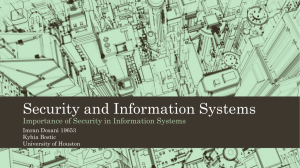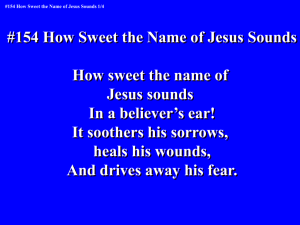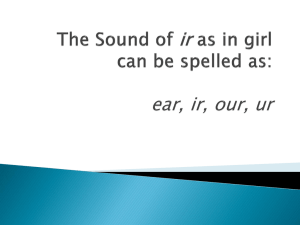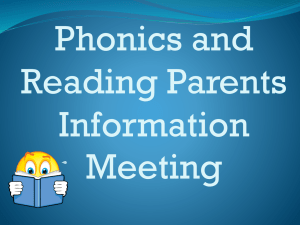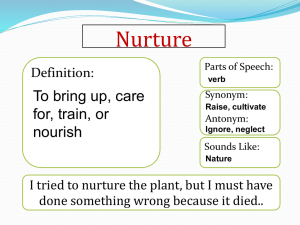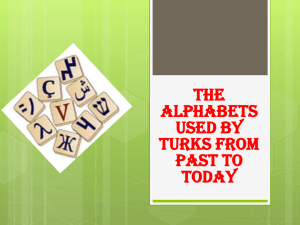Teaching ELL to Read
advertisement
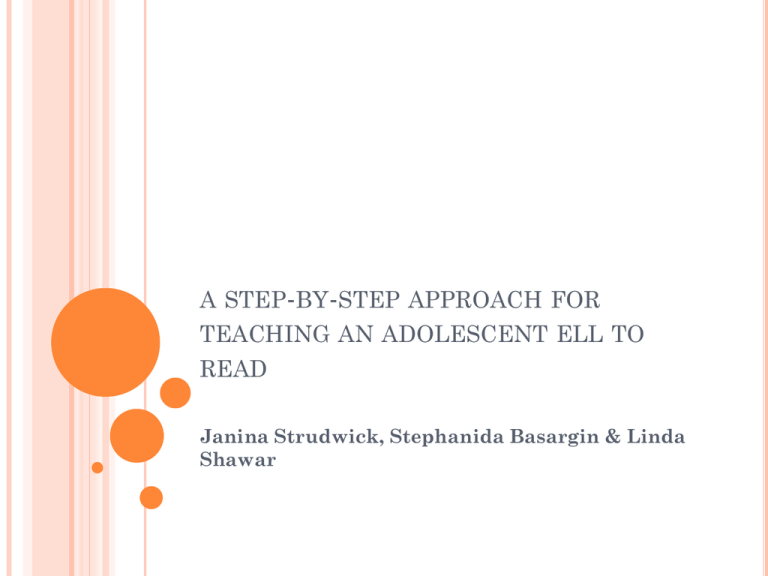
A STEP-BY-STEP APPROACH FOR TEACHING AN ADOLESCENT ELL TO READ Janina Strudwick, Stephanida Basargin & Linda Shawar HOW TO TEACH AN ADOLESCENT ELL TO READ 1.Begin at the syllable level, for example, identify the two syllables in rabbit (Brown, 2001). 2.Then rhymes and knowing sounds at the beginning of the word: onset and rhymes, what the sound is that starts off the word (onset) and the one at the end is the rhyme (Bell and Burnaby, 1984). 3. Third level is phoneme, break match into mat-ch : phonological awareness scaffolds into reading skills (Jay & Jay, 1998). READING Students can start to read Scaffold to discriminate written symbols Hear different pronunciation of letters Development of clear speech Encourage students to speak Teacher needs to speak a lot STAGE 1. RECOGNIZE SYLLABLES To recognize syllables try the clapping game. Variations: place numbers in each part of the room and when you say a word, students must go to that corner (Brown 2001) some students can't hear the syllables to clap them. Have them put their hand flat under their chin and count the number of times it goes down when they say a word (ProTeacher, 2008). NEXT: As you teach syllables orally, try to start some recognition of written symbols BASIC RECOGNITION OF LETTERS: Preliteracy, recognizing letters: adults or mature youth may need to learn to discriminate between small shapes or recognize common features in groups of objects, and may lack fine motor coordination to hold a pen. To make sure this is not demeaning, have many activities to help students move along quickly (Bell & Burnaby, 1984). For example, instruct students to read left to right, the difference between p and q, and the relative size of s and S (Bell & Burnaby, 1984). Scaffold from circles and squares to left or right facing characters (d and b for example) to regular sized typeface letters and numbers (Bell & Burnaby, 1984). See example in next slide. (Bell & Burnaby, 1984, p. 30) (Bell & Burnaby, 1984, p. 37) PARTS OF A BOOK Adapted lesson outcomes from Jay and Jay (1998): Outcomes: develop understanding of front and back, inside and outside, up and down, spine, pages, title page, text, illustrations, text from left to right and top to bottom. Various languages have text arranged in different ways. Sequence of events in a story: knowing before and after. Knowing what an event is, ability to identify events in a story. Materials: English language books, Japanese books, Arabic books. Stage 2: Initial consonant recognition and rhymes ALPHABET ORAL WORK ABCs or MNWs? Suggestion to teach alphabet not necessarily in order of ABC but in clusters of letters which appear similar and then explain the differences (Bell & Burnaby, 1984). What other clusters might you think of to teach together? Try not to begin with letters like c which have more than one sound. When you do introduce a letter, present it on the board in upper and lower case and use it in a student’s name. Do not suggest “t as in ‘tuh’ sound” since that is a distortion of how T is pronounced in Tomas (Bell & Burnaby, 1984). •Have students make their own memory cards based on the words starting with T. Using something that they can easily draw, have them draw the image (e.g., a table) on the card and write T, t, table, Tomas, and any other words that they think will help them remember (Bell & Burnaby, 1984, p. 39). •For numbers, use cards with a corresponding number of dots (e.g., 3 ***) (Bell & Burnaby, 1984, p. 39) At the same time you instruct discrimination of shapes, introduce basic oral work such as “What’s your name? My name is ______.” The teacher will write the student’s name on a paper and students are expected to copy it, scaffolding to the rest of the dialogue and adding address, first and last to be able to fill out a form (Bell & Burnaby, 1984, p.38). The real world value of this task will motivate students to apply themselves despite the limited skill in writing at this stage. (Bell & Burnaby, 1984, p.38) RHYMING SOUNDS Adapted sample lesson from Jay & Jay (1998, p. 6): Outcomes: Students understand the same ending sound of rhyming words The written letter symbol’s connection to spoken sound Letter symbols have more than one sound Materials: ABCs, rhyming books, magazines, mail-order catalogues, picture books Procedure: Students match printed words with what is being read to them, to begin to identify the sound/letter relationship. Students suggest words that begin with the same sound, as a familiar word such as their name or common objects: Badri, boy, book, boat, and so on. Start exploring examples of rhyming words. Create lists of word families e.g., bat, cat, fat; fit, hit, lit, mit, sit. Find examples of rhyming word patterns in stories and poems. e.g.: Beastie Boys game APPLICATION Get into groups of 3 and collectively write a 2 line rap using the following phrases or words in any combination. This version has students ‘write’ by assembling flashcards with words & phrases prewritten on them. School, rule, the pool I like to Cook, book, look, I go to Bus, fuss, I like the My house, mouse, I follow the I go to school I like to cook I take the bus I like the pool I like the book I don’t fuss I like (go to) my house I follow the rule I like to look (Jay & Jay, 1998, p. 6) PERFORMANCE OF SONG ‘Beastie Boys’ game: in a circle, students clap hands and first one sings aloud his rap, and then the next student repeats the first rap, then reads her rap. The third student repeats the second girl’s rap and then sings his own, etc. until all have sung their songs (Jay & Jay,1998, p. 6). See video. VARIOUS NEXT STEPS: SOUNDS Adapted from Jay & Jay (1998, p. 6). Extensions: Explore examples of letters having more than one sound, short and long vowels, hard and soft consonants, and the effect of phonics rules. Explore examples of diphthongs and consonant blends. Explore examples of homographs, where words spelled the same way sound different when they have different meanings (bow of boat and bow in your hair). Explore homophones (or homonyms), in which the words sound the same but have different spellings for different meanings (to, too, two). Have fun with words whose sound is also its meaning (boom, snap, crack, etc.). STAGE 3: PHONOLOGICAL AWARENESS Stephanida will take us through phonemes as well as strategies students can use when learning to read such as decoding and chunking. PHONEMIC AWARENESS The understanding that words are made up of individual sounds. Phonemes The individual sounds in the spoken language. WHY FOCUS ON PHONEMIC AWARENESS Learning letter names and sounds has been repeatedly demonstrated as one of the strongest and most stable predictors of early reading success for a diversity of student populations (Reutzel & Cooter, 2011, p. 134). Letter naming learning is considered central and typical of the process of becoming a reader (Reutzel & Cooter, 2011, p. 135). WHERE DO YOU BEGIN… The English alphabet has 26 letters and 44 sounds which can be represented 350 different ways (Reutzel & Cooter, 2011). Ruetzel and Cooter (2011) suggest beginning with rapid naming/identification and knowing the sounds they represent. Sound Spellings Examples b b, bb ball d d, dd, ed dot f f, ff, ph, lf fn ACTIVITIES Songs and poems that stress sounds. Peas Porridge Hot Word detectives One way of implementing phonological awareness without the student feeling isolated or on the spot is through music class. Students find words beginning with the target letter. Flash cards Beginning sounds match with the picture. (Reutzel & Cooter, 2011) HELPING STUDENTS BEGIN TO DECODE Onset and Rime (Ruetzel & Cooter, 2011, p. 167) The vowel at the beginning of the syllable and the rest of the letters that follow is a rhyme The letters that are before the vowel is the onset t – ack sn – ow tr – ack Rhymes should be taught first, and when combined with various onsets, will produce around 500 primary level words. HELPING STUDENTS BEGIN TO DECODE Body and coda, or chunking (Ruetzel & Cooter, 2011, p. 167). Body is the onset and the vowel after the onset Coda is everything fallowing the vowel Strea-ming Recent studies show it may be more effective than onsets and rhymes. Would anyone know why it is more effective? APPROACHES TO TEACHING ENGLISH Phonological Individual sounds Looks at the parts of the word and then the word Bottom-up approach Whole language Looks at the whole word Usually stresses memorization Top-down approach Combination of both are used. RESPONSE TO INTERVENTION (RTI) Three-Tiered Instruction Begin with the Core Classroom Instruction Supplemental Intervention Working in small groups using the push in or pull out method. Works on areas in which the student needs help. Intensive Intervention Small groups or individual Still inclusive but with more pullout time. Intensive and individualized approach helps the student. (Reutzal& Cooter, 2011, p. 47) STRATEGIES FOR TEACHERS Know where you student is at and do not push your student to their frustration level. Sequence your instruction. Needs to be done daily. Class routine should be predictable (this will ease the stress of the students trying to figure out/keep up with the class routine). Focus on one skill at a time – letter recognition, decoding, spelling, rhyming. Keep lessons brief (10-15 minutes, keeping zone of proximal development in mind). Use easy reading material (not difficult material that was simplified). Be clear what you are trying to teach the student – speak to the student in their first language or have a translator in the beginning to help, use a dictionary. Be flexible. (Reutzal& Cooter, 2011) LESSON PLAN – THE FIRST STEP o o o Goal: Begin to identify letter shapes and sounds. Objectives: Begin to differentiate between letter shapes and understand their differences and begin to learn letter sounds. Assumptions being made: It is assumed that the students in this Grade 8 junior high classroom have no reading skills in the L1 or L2. While the audience is a group of adolescent students, the basics of the alphabet must be introduced to build a solid foundation for later learning. LESSON PLAN – THE FIRST STEP Procedures: To begin this process the students will be shown the alphabet as a whole in uppercase on the smart board. The letters of the alphabet will then be shown individually while the instructor gives the students the letter name and sounds. After this has been completed the students will begin to write the letters of the alphabet one by one as a class. This may need to be repeated. Once this has been completed the instructor should ask the students which letters have similarities and what the major difference is between them. These similar letters (D/B, P/Q, M/W) should be discussed and letter sounds should be included in this process. LESSON PLAN – THE FIRST STEP Later the students should be introduced to the lowercase letters and the alphabet with both cases on display. At this point the students can practice writing the lowercase letters as they did with the uppercase. Once the students are comfortable with writing the letters and have a basic understanding of letter sounds they can be further challenged by trying to write from memory. Hold up large flashcards at the front of the class that show the letters individually in both cases while saying the letter sound. Then put the flashcard down and allow the students some time to write the letter from memory. Do this for all 26 letters, pausing frequently to check on progress. During this process some rules of reading should be introduced, including that English is read from left to right. LESSON PLAN – THE FIRST STEP Assessment: Assessment should follow the same model as the flashcard activity. It is still too early to ask students to write completely from memory, especially those students who have L1’s in which the written characters do not correspond to the English alphabet. Homework/Extra Class Work: Students should be directed towards videos of the alphabet being shown while the letter sounds are being made (TeacherMelanie, 2010). http://www.youtube.com/watch?v=jaHvC_qtT8s LESSON TWO –SYLLABLE AWARENESS Goals: Generate awareness of the principle that words are made up of separable sounds. Objectives: To introduce the students to syllables To enhance the ability of students to separate words into syllables Materials: Smart board or projector Text to speech software Assumptions being made: It is assumed that the students have some knowledge of the English alphabet and letter sounds. It is assumed that the students have no reading skills in their L1 and L2. LESSON TWO –SYLLABLE AWARENESS Procedure: Begin the lesson by asking students to think about a word in their L1. One by one ask them to say the word to the class and explain its meaning. Ask them that if they could separate their words into parts to shout out how many parts their word has. Then ask them individually to repeat their word and to break it into parts for the class. Once the students have all completed this introduce the concept of syllables. Ask them to think about one or two other words in their L1 and to talk with a partner about the meanings of those words and the number of syllables in them. LESSON TWO –SYLLABLE AWARENESS Allow 2 – 3 minutes for this. Explain to the students that English words are also broken into syllables. Show the students the ‘under the chin method’ (ProTeacher, 2008) for counting syllables using their L1. Ask the students to think of one English word and then ask the first student what their word is. Put this word into the text-tospeech software and allow the students to listen to it a few times. Then ask them how many syllables the word has. Remind them that they can use the under the chin method. One by one complete this process with every student. REFERENCES Bell, J. & Burnaby, B. (1984). A handbook for ESL literacy. Toronto: OISE Press. Brown, D. (2001). Teaching by principles. New York: Longman. Jay, E. & Jay, H. (1998). 250+ activities and ideas for developing literacy skills. New York: Neal-Schuman Publishers. Reutzel, D., & Cooter, R. B., Jr. (2011). Strategies for reading assessment and instruction: Helping every child succeed (4th ed.). New Jersey: Prentice Hall. ProTeacher. (2008). How to teach syllables. Retrieved from: http://www.proteacher.net/discussions/showthread.php?t=1 19725 TeacherMelanie. (2010). How to say the English alphabet [YouTube video] Retrieved from: http://www.youtube.com/watch?v=jaHvC_qtT8s


